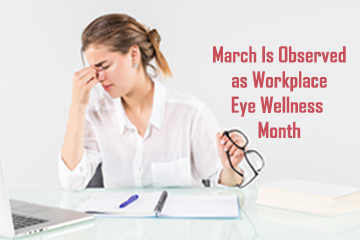Job-related eye injuries are getting more common. The Centers for Disease Control and Prevention (CDC) reports that each day approximately 2,000 U.S. workers sustain a job-related eye injury that requires medical treatment. About one third of these injuries are treated in hospital emergency departments, and more than 100 result in one or more days away from work. During this COVID-19 pandemic, remote working has increased, which increases the risk of digital eye strain. March has been declared as Workplace Eye Wellness Month by Prevent Blindness, the nation’s oldest eye health and safety nonprofit organization.
During 2021 Workplace Eye Wellness Month, Prevent Blindness aims at raising awareness of digital eye strain and provides tips on ways to reduce the effects of increased screen time. Digital eye strain or computer vision syndrome (CVS) refers to a group of eye and vision-related problems that result from prolonged use of digital devices such as computer, tablet, e-reader, smartphone and others. Discomfort can increase with the amount of digital screen use. The most common symptoms associated with CVS are eyestrain, headache, blurred vision, dry eyes, and neck and shoulder pain. Uncorrected vision problems can increase the severity of digital eyestrain symptoms. These symptoms are mainly caused by poor lighting, glare on a digital screen, improper viewing distance, poor seating posture or uncorrected vision problems.
It is important to take regular eye examinations and follow proper viewing habits to prevent or reduce the development of the symptoms associated with CVS.
Prevent Blindness provides certain tips to improve healthy vision at work, which include
- Placing your screen 20 to 26 inches away from your eyes and a little bit below eye level
- Using a document holder next to the screen to avoid swinging your head back and forth or constantly changing eye focus
- Changing the lighting to reduce glare and harsh reflections
- Using an adjustable chair
- Choosing screens that can tilt and swivel and an adjustable keyboard
- Using computer glasses with yellow-tinted lenses that block blue light to ease digital eye strain by increasing contrast
- Using anti-reflective lenses to reduce glare and increase contrast, and block blue light from digital devices
The American Optometric Association (AOA) recommends taking frequent breaks by using the “20-20-20” rule, which means that every 20 minutes you have to look away from your screen and look at an object 20 feet away for at least 20 seconds. This gives your eyes a chance to reset and replenish themselves. AOA also recommends blinking frequently to minimize the chances of developing dry eye when using a computer. Blinking keeps the front surface of the eye moist.
Workers in other settings such as construction or manufacturing can consider using safety eyewear protection such as non-prescription and prescription safety glasses, goggles, face shields, welding helmets and full-face respirators. This helps to protect the eyes and face against any chemical, environmental, radiological or mechanical irritants and hazards.
